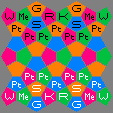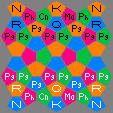SerPent Chess 50
This variant was originally devised for a future 50-cell contest. After variants in two other pentagonal or putatively-pentagonal geometries were posted I realised that I needed a distinctive name for this one. At one stage I toyed with calling it Pentecostal Chess, with no thought to the time of year but simply allusing to the fact that it had 50 cells, but rejected this name as for the same reason it could not be extended to variants on boards of other sizes in this geometry.Eventually I chose a name referring to the fact that all directions are to some extent non-Straight. As this geometry lacks Straight pieces I initially planned to use their names for the pieces that are only slightly Crooked. However, I soon realised how easy it is to naively create a 3d geometry from a 2d one by stacking 2d boards together as levels or ranks with the third dimension at right angles to them. I therefore decided to give them new names and themed these names on the name of the variant.
I devised long-range pieces with the moves of one or more of a Rook analogue, a Bishop analogue, a Finch analogue, and the King, and looked at basing the pieces' initials on this analogy. The decision was influenced by David Jagger's choice of piece initials in PiRaTeKnIcS, and a further decision of mine made the parallel even closer. On failing to find a snake name starting with F for Finch (let alone anything suiting Finchrider or Primaranger) I thought of switching the names of the Finch analogue and its compounds to be based on the Knight and its compounds, as I do not consider oblique directions on this page and the pieces are in the same proportions as Carrera/Bird/Capablanca pieces. They can be physically represented in the same way as those - see Notes. Even this way I had to resort to an archaic form of Adder to get a name starting with the N usually used as the letter for Knight. As Asp and Anaconda, to say nothing of Egypt's serpentine deities Ankhtith and Apep, can fulfil any need for a piece in this geometry starting with A, losing the modern form of Adder is no hardship. I also devised versions of forward-only pieces, to use in a variant based on Mitregi, and named after type of crooked movement. Each variant has both a very asymmetric version and, by rotating the board through 90°, a less asymmetric one. I did not use a forward-only version of the Nadder as this would be restricted to moving 1, 2, or 3 cells forward depending on position and starting direction and seemed too complex to explain easily.
Setup
Version A |
Version C |
| These two are based on Knighted-piece variants, with two each of three basic pieces and one each of their two-part compound. | These two are based on Mitregi, with forward-only pieces and Shogi generals. |
Version B |
Version D |
Pieces
The KING (K) moves to any orthogonally or diagonally adjacent cell - even directionsa in all - and must be kept out of Check.The RATTLESNAKE (R), named after a snake sharing the initial of Rook, moves along the orthogonals. The single orthogonal step of the Wazir remains a step between two cells adjoining at a side. The problem starts when trying to define a continuous line-move, as each side is opposite a corner. A two-step orthogonal move can be defined as two successive Wazir steps that have the same general direction in the sense that the orthogonal and diagonal step of a Mao move do. As the Maorider, and hence all the other pieces on the Rhino page, alternate between left and right turns, so does the Rattlesnake. This defines four kinds of orthogonals.

|

|
| File Orthogonals run along chains of File Hexagons joined end to end. They alternate between the red cell of one FH and the green cell of the next, and vice versa, with an orange and a blue cell in between each pair. The File Orthogonals are marked out in pink and cream in the diagram above. Rank Orthogonals run along chains of Rank Hexagons joined end to end. They alternate between the orange cell of one RH and the blue cell of the next, and vice versa, with a red and a green cell in between each pair. The Rank Orthogonals are marked out in pale green and mauve in the diagram above. | Bend orthogonals run between the right-hand parts of the two camps, from their own players' viewpoints. They alternate strictly between either red and orange cells, or green and blue ones. They are named after a heraldic device called a Bend which runs the same way across a shield. The Bend Orthogonals are marked out in cream and pale green in the diagram above. Scarp orthogonals run between the left-hand parts of the two camps, from their own players' viewpoints. They alternate strictly between either red and blue cells, or orange and green ones. They are named after a heraldic device called a Scarp which runs the same way across a shield. The Scarp Orthogonals are marked out in pink and mauve in the diagram above. |
The WAGGLE (W), named after a crooked motion sharing the initial of Wing, moves like a Rattlesnake but only forward along file orthogonals.
The NADDER (N) named after an archaic form of Adder sharing the initial usually used for Knight differs from the Rattlesnake in that instead of alternating between left and right turns it makes moves comprising either only left turns or only right turns. This results in it encircling Hexagons, just as the Finch encircles hexagons that are individual cells.

|

|
| Nadder paths encircling File Hexagons are marked out in the diagram above. | Nadder paths encircling Rank Hexagons are marked out in the diagram above. |
The PYTHON (Ph), named after a snake sharing the initial of Primate moves like the Boa, a very weak piece moving along the diagonals and named after a snake sharing the initial of Bishop, or the King. The single diagonal step of the Ferz remains a step between two cells adjoining at a corner. A two-step diagonal move is again defined as two successive Ferz steps in the same general direction, but each cell is on only two such Ferz paths anyway. This makes it inevitable that the Boa alternates between left and right turns. This defines two kinds of diagonals.

File Diagonals alternate strictly between red and green cells. The File Diagonals are marked out in pale green and mauve in the diagram above. Rank Diagonals alternate strictly between orange and blue cells. The Rank Diagonals are marked out in pink and cream in the diagram above. Note that no two diagonals intersect. This binds a plain Boa to a single diagonal, which is why I "crown" it to a Python in this game.
The MEANDER (Me), named after a crooked motion sharing the initial of Mitre, moves like a Boa but only forward along file diagonals.
The MAMBA (Ma), named after a snake sharing the initial of Marshal, is the compound of Rattlesnake and Nadder, and can either alternate left and right turns or stick to one kind of turn in a move. Note that it still cannot mix left and right randomly.
The QUETZALCOATL (Q), named after a serpentine Aztec deity sharing the initial of Queen, is the compound of Rattlesnake and Boa, and moves along all the alternating paths.
The CONSTRICTOR (Cn), named after a generalisation of Boa sharing the initial of Cardinal, is the compound of Nadder and Boa, and alternates left and right turns when moving diagonally but sticks to one kind of turn in an orthogonal move. Note that it still cannot mix left and right randomly.
The GOLDGENERAL (G) moves to any orthogonally adjacent cell, or the next cell forward along a file diagonal.
The SILVERGENERAL (S) moves to either diagonally adjacent cell, or the next cell forward along a file orthogonal.
The PRINCELING (Pg) moves one step forward along File Orthogonals and (if there are any) File Diagonals. It is because some cells are not on a File Diagonal that I use a full Princeling rather than the divergent Pawn, which would not always have a capturing direction available.
The POINT (Pt) moves one step forward along File Orthogonals only.
No attempt is made to define oblique directions.
Rules
Princelings starting on a Rank Diagonal have an optional initial double-step noncapturing move. Immediately after making such a move they may be captured En Passant by a suitably placed enemy Princeling from any starting cell, as if it had made only the first step, if such a piece is so placed to do so. Points have no double-step move.Version A has four kinds of Castling. On the King's side, the King moves to the Nadder cell, and the Rattlesnake to the Mamba or Python cell. On the Quetzalcoatl's side, the King moves to the Constrictor or Python cell, and the Rattlesnake to the Quetzalcoatl cell. Version B also has four kinds of Castling. On each side the King moves to the Python cell and the Rook or Nadder to the Nadder-compound cell. Those oddities apart, FIDE Castling rules apply. Versions C and D have no Castling.
A piece reaching a cell from which it has no further forward move (although it may have backward or sideways ones) must be promoted as follows: Rook (Versions C and D only) to Cobra, Silver/Waggle/Meander/Point to Gold, Princeling to any stronger capturable array piece.
Versions C and D allow pieces to return from capture as part of the capturing player's army, in place of a normal move. They must return in unpromoted form, on a cell from which they have a forward move. Note that in the Meander's case this means that it must be placed on a file diagonal rather than a rank diagonal. As file orthogonals occur in overlapping pairs, a player may not have more than two unpromoted Points on the same pair of file orthogonals.
Check, Checkmate, and Stalemate are as usual.
Notes
Versions A and B can be played with either purpose-built Knighted-piece sets or Shogi sets, using the following substitutions. Versions C and D require a Shogi set. Kings would of course represent themselves.| Versions A and B piece | Versions C and D piece | Knighted-set piece | Shogi piece |
|---|---|---|---|
| Quetzalcoatl | Gold | Queen | Gold |
| Mamba | Rattlesnake | Marshal | Rook |
| Constrictor | Cardinal | Bishop | |
| Rattlesnake | Waggle | Rook | Wing |
| Python | Silver | Bishop | Silver |
| Nadder | Meander | Knight | Helm |
| Princeling | Point | Pawn | Point |
 This 'user submitted' page is a collaboration between the posting user and the Chess Variant Pages. Registered contributors to the Chess Variant Pages have the ability to post their own works, subject to review and editing by the Chess Variant Pages Editorial Staff.
This 'user submitted' page is a collaboration between the posting user and the Chess Variant Pages. Registered contributors to the Chess Variant Pages have the ability to post their own works, subject to review and editing by the Chess Variant Pages Editorial Staff.
By Charles Gilman.
Web page created: 2010-10-09. Web page last updated: 2011-12-01